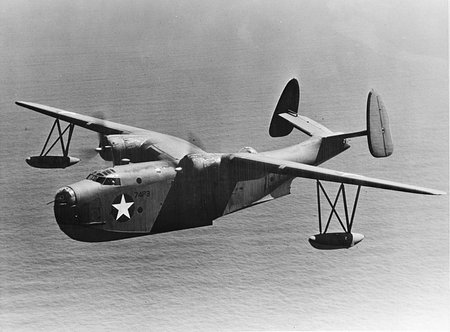Loss of PBM Martin Mariner
In Bermuda Triangle
This incident took place on the same night of December 5, 1945 when all the
Five planes of Flight-19 went missing in the infamous Bermuda Triangle area. Finally the order came from the US Navy to send two Martin Mariner planes to start the search operation and locate the Flight-19 planes.
It was past 7pm and the Navy had given up hope that the Fligh-19 planes were still going to make it. So the two PBM Martin Mariners, that were essentially flying boats that could fly as well as float on water took off at 7.27pm from the Banana River Navy Air Station in Florida.
The Martin Mariners were heavily used by the U.S those days to patrol the ocean areas, detect any enemy submarine operations, and rescue pilots and crew who would have crashed into the Atlantic. They had the ability to easily land on the ocean. Mariners used to carry huge amount of fuel so that they could carry out a search operation over long hours, if required.
A PBM Martin Mariner
So, the two such Martin Mariners took off, this time to search for the Flight-19 planes. Both the mariners were generally used for training purposes. But this time they were on a special mission. One of them, known as the Training-32 headed straight out into the ocean. The second one, named Training-49 went north bound along the east coast. However, after the second Mariner took off, the base station never heard from it again.
It was at 9:12pm, when a message came in from a freighter ship SS Gaines Mill that was cruising off the coast of Florida that they saw a large ball of fire dropping into the ocean followed by a huge explosion at a short distance away. The message said... "At 1950, observed a burst of flames, apparently an explosion, leaping flames 100 feet high and burning for 10 minutes. Position 28 degrees 59 minutes north, 80 degrees 25 minutes west. At present, passing through a big pool of oil. Stopped, circled area using searchlights, looking for survivors. None found."
Training-32 was still searching for the Flight-19 and was in constant touch with the base station. At 9.45pm, the Training-32 mariner was asked to get to the spot reported by the freighter ship where the explosion took place (about 25 miles east of New Smyrna Beach, Florida). But strangely, when they reached the area at 10:45pm, they saw no fire there, no oil slicks, nor any debris floating.
Although the Captain of SS Gains Mill reported that his crew had noticed oil slicks and debris floating on water, the water sample brought in from that ocean area did not show any trace of oil that could suggest an explosion. Even the Pilot of Training-32 mariner which scanned the explosion area reported that he did not find any oil slicks or debris. But the crew of the freighter SS Gains Mill confirmed that they did see a huge ball of fire dropping into the ocean and then a big explosion taking place.
So what really happened to the Martin Mariner?
The captain of SS Gains Mill confirmed that he saw a plane catching fire and then crashing into the sea and exploding. Next day, there was a message from USS Solomons (CVE 67) that participated in the search operation in the previous night. The message said... "Our air search radar showed a plane after takeoff from Banana River last night joining with another plane (the second PBM), then separating and proceeding on course 045 degrees at exact time the SS Gaines Mills sighted flames and in exact spot the above plane disappeared from the radar screen and never reappeared."
So it was quite clear that the second Mariner (Training-49) was the plane that caught fire and dropped into the ocean and caused the explosion. Even if the crew of SS Gains Mill noticed some floating debris, it was not possible to pick it up because the sea was very rough on that night.
However, The mariner was in the best of conditions and thoroughly checked by both technicians as well as the captain before taking off. So any engine failures or such were ruled out.
Some analysts speculated that a cigarette lighting inside the cabin would have blown up the plane. That theory was ruled out too. Since the mariners carried huge amount of gas, in-flight smoking was strictly prohibited and no one should have lit a cigarette.
Now an interesting observation... The US Navy Board during the investigation reported that some greenish lights are often seen along the coast lines of Florida. This phenomenon has also been confirmed by the residents living on the Florida coast. This green light would float around for a while, then descend and slowly disappear.
This is often related with something known as St. Elmo's fire which has a green hue. The fire is caused due to the area's unique climate. It radiates huge amount of electrical charge. And it is also known that airplanes seem to glow green when they come under the charge from such Elmo's fire even though they have anti-static equipment. And in one such occasion, a plane had actually blown up.
From previous several instances, it was known that the Mariners were prone to explosions due to gas leakage from their tanks, particularly when the tanks were fully loaded. In fact by then, the Martin Mariners were already nicknamed as 'Flying Gas Tanks'. So was it such electrical charge from Elmo's fire that interfered with the navigational system or caused the fire and blew up the Mariner? This is a possible theory. But this has not yet been established with facts and evidence.
However, following this incident, the US Navy grounded all Martin Mariners. Unfortunately the investigation of Martin Mariner is still incomplete and remains as a mystery of Bermuda Triangle.
|
 By Raj Bhattacharya By Raj Bhattacharya
Raj, a seasoned travel writer and Bermuda destination expert, has extensive global travel experience. This website reflects his profound insights, garnered over nearly two decades of dedicated findings and research on the island. Raj has assisted countless Bermuda-bound visitors by providing direct, personalized responses to their queries and imparting his wealth of knowledge through this platform. This site serves as an indispensable guide for those seeking informed and reliable insights into Bermuda's treasures.
|
Related Articles

 By Raj Bhattacharya
By Raj Bhattacharya